

1 VIRTUAL CHARTER SCHOOLS August 27, 2018 Chad L. Aldis, Vice President for Ohio Policy and Advocacy Thomas B. Fordham Institute
2 Outline • Introduction • Challenges Facing Virtual Charters • Lessons Learned • Opportunities for State Improvement • Recommendations
3 Who are we? • Thomas B. Fordham Institute is a non-profit 501c3 • Founded in Dayton; current offices in Dayton, Columbus, and Washington, D.C. • Started as a think tank focused on research and commentary • Now Columbus office engages in policy advocacy and Dayton office is a charter authorizer • Support charter schools but are critical at times • Quality choices and improved student achievement drive our charter work
4 Ohio’s experience • More than 35,000 virtual charter students • 13 statewide online charters • As early as 2001, Ohio’s state auditor raised concerns • Efforts to improve sector included a virtual school moratorium, requirement to develop virtual school standards, and enrollment limits • Sector continued to struggle • In 2016, ODE changed the way it was verifying enrollment and funding schools • Result—major funding changes • ECOT—Ohio’s largest online charter closed
5 Framing the Issue—Challenges Facing Virtual Charter Schools • Academic performance • CREDO study • State report cards • Serving challenged students • Public relations issues
6 Lessons Learned • Tremendous interest from families • Despite negative PR • Only choice in many communities • Online education is only going to grow • Some students struggle in online setting • Academic performance stubbornly low • Level of student engagement varies widely • Delivering instruction online poses special challenges
7 Opportunities for Improvement (States) • Student orientation • Disenrollment • Failure to participate • Excessive absences • Measuring academic performance • Graduation rate • Mobile students • Proper authorizing role • Statewide • Too big to fail, fee structure • How to fund • Enrollment, participation, or competency/completion
8 Recommendations - Leverage • Allow/Require a student orientation/disenrollment process • Adopt a funding mechanism that works with your state context and provides clear incentives • What enrollment duration generates funding? • Does student achievement play a role in funding? • Improve academic measures(applies to all schools) • Graduation rate • Mobility
9 For more information, visit: www.edexcellence.net/ohio-policy Or email us at: Chad Aldis – caldis@edexcellence.net
Recommend
More recommend